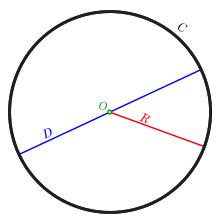Ingeometry,thecircumference(from Latincircumferens,meaning "carrying around" ) is theperimeterof acircleorellipse.[1]The circumference is thearc lengthof the circle, as if it were opened up and straightened out to aline segment.[2]More generally, the perimeter is thecurve lengtharound any closed figure. Circumference may also refer to the circle itself, that is, thelocuscorresponding to theedgeof adisk. Thecircumference of a sphereis the circumference, or length, of any one of itsgreat circles.

Circle
editThe circumference of a circle is the distance around it, but if, as in many elementary treatments, distance is defined in terms of straight lines, this cannot be used as a definition. Under these circumstances, the circumference of a circle may be defined as thelimitof the perimeters of inscribedregular polygonsas the number of sides increases without bound.[3]The term circumference is used when measuring physical objects, as well as when considering abstract geometric forms.
Relationship withπ
editThe circumference of acircleis related to one of the most importantmathematical constants.Thisconstant,pi,is represented by theGreek letterIts first few decimal digits are 3.141592653589793...[4].Pi is defined as theratioof a circle's circumferenceto itsdiameter
Or, equivalently, as the ratio of the circumference to twice theradius.The above formula can be rearranged to solve for the circumference:
The ratio of the circle's circumference to its radius is called the circle constant, and is equivalent to.The valueis also the amount ofradiansin oneturn.The use of the mathematical constantπis ubiquitous in mathematics, engineering, and science.
InMeasurement of a Circlewritten circa 250 BCE,Archimedesshowed that this ratio (written assince he did not use the nameπ) was greater than 310/71but less than 31/7by calculating the perimeters of an inscribed and a circumscribed regular polygon of 96 sides.[5]This method for approximatingπwas used for centuries, obtaining more accuracy by using polygons of larger and larger number of sides. The last such calculation was performed in 1630 byChristoph Grienbergerwho used polygons with 1040sides.
Ellipse
editCircumference is used by some authors to denote the perimeter of an ellipse. There is no general formula for the circumference of an ellipse in terms of thesemi-major and semi-minor axesof the ellipse that uses only elementary functions. However, there are approximate formulas in terms of these parameters. One such approximation, due to Euler (1773), for thecanonicalellipse, is Some lower and upper bounds on the circumference of the canonical ellipse withare:[6]
Here the upper boundis the circumference of acircumscribedconcentric circlepassing through the endpoints of the ellipse's major axis, and the lower boundis theperimeterof aninscribedrhombuswithverticesat the endpoints of the major and minor axes.
The circumference of an ellipse can be expressed exactly in terms of thecomplete elliptic integral of the second kind.[7]More precisely, whereis the length of the semi-major axis andis the eccentricity
See also
edit- Arc length– Distance along a curve
- Area– Size of a two-dimensional surface
- Circumgon– Geometric figure which circumscribes a circle
- Isoperimetric inequality– Geometric inequality which sets a lower bound on the surface area of a set given its volume
- Perimeter-equivalent radius– Radius of a circle or sphere equivalent to a non-circular or non-spherical object
References
edit- ^San Diego State University(2004)."Perimeter, Area and Circumference"(PDF).Addison-Wesley.Archived fromthe original(PDF)on 6 October 2014.
- ^Bennett, Jeffrey; Briggs, William (2005),Using and Understanding Mathematics / A Quantitative Reasoning Approach(3rd ed.), Addison-Wesley, p. 580,ISBN978-0-321-22773-7
- ^Jacobs, Harold R. (1974),Geometry,W. H. Freeman and Co., p. 565,ISBN0-7167-0456-0
- ^Sloane, N. J. A.(ed.)."Sequence A000796".TheOn-Line Encyclopedia of Integer Sequences.OEIS Foundation.
- ^Katz, Victor J. (1998),A History of Mathematics / An Introduction(2nd ed.), Addison-Wesley Longman, p.109,ISBN978-0-321-01618-8
- ^Jameson, G.J.O. (2014). "Inequalities for the perimeter of an ellipse".Mathematical Gazette.98(499): 227–234.doi:10.2307/3621497.JSTOR3621497.S2CID126427943.
- ^Almkvist, Gert; Berndt, Bruce (1988), "Gauss, Landen, Ramanujan, the arithmetic-geometric mean, ellipses,π,and the Ladies Diary ",American Mathematical Monthly,95(7): 585–608,doi:10.2307/2323302,JSTOR2323302,MR0966232,S2CID119810884